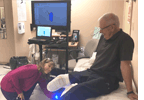Innovation
Computerized imaging improves prosthetics in Sudbury
December 5, 2018
 SUDBURY, Ont. – Health Sciences North is passing on plaster and introducing patients to the most cutting edge approach available to creating prosthetic and orthotic devices, a first for Sudbury and Northeastern Ontario. As a result, “What used to take two hours, now takes twenty minutes. Wait times for new patients have been cut in half,” says Kristin Schafer, a certified prosthetist at HSN.
SUDBURY, Ont. – Health Sciences North is passing on plaster and introducing patients to the most cutting edge approach available to creating prosthetic and orthotic devices, a first for Sudbury and Northeastern Ontario. As a result, “What used to take two hours, now takes twenty minutes. Wait times for new patients have been cut in half,” says Kristin Schafer, a certified prosthetist at HSN.
In addition, says Schafer, “You can capture every little bump and contour so the limb segments are more accurately captured. It’s a real time saver for both the clinician and the patients.”
Health Sciences North is using the Spectra 3D Scanner and Canfit Design Software, which are produced by Vancouver-based Vorum Research Corp. Vorum is a world-leader in computer-aided design for prosthetics and orthotics.
The computerized method, mastered by members of the Prosthetics and Orthotics team at HSN since the spring, is safe, easy to use, and significantly reduces wait times, for an improved patient experience.
“This advanced technology is far more accurate and precise than other methods,” says David Filipovic, a Certified Orthotist at HSN. “We don’t have to use messy plaster anymore or mechanical tools to remove the cast from the patient, which would sometimes end up deforming the device.
“This process was sometimes uncomfortable for patients, especially those with cognitive disabilities, sensitive skin, or patients with chronic pain.”
Filipovic adds, “This technology is a game changer as it results in more accurate and repeatable treatments with the added advantage of storing a permanent digital record.”
The Spectra 3D Scanner is a small hand-held device and, in a matter of seconds, quickly and accurately captures three dimensional data points for all types of orthotic devices, spinal braces, as well as many different types of prostheses.
The Certified Orthotist or Prosthetist can then use specialized design software to produce a better fitting treatment device, one that aligns and supports more effectively, reduces excess joint movement, avoids pressure points, and eliminates gaps that can cause a decrease in support to the affected area.
JC Roy, 72, is a recent patient at HSN who has benefited from this technology. Last April, while vacationing in Mexico, he developed an infection in his foot which eventually got into his bones and moved up his leg.
As his condition worsened, Roy went to see his doctor who said the leg needed to be amputated below the knee. Despite the situation, Roy’s optimism is miraculous. “Life is not going to end, you know. It’s just one leg. I still have another one and I’m making a lot of progress with my new prosthetic.”
“I also want to thank the hospital for helping me so much with my new limb. The staff here have been excellent and very helpful. Getting scanned and fitted for my new limb was a breeze.”
Staff with HSN”s Prosthetic and Orthotic Services are excited to bring this new technology to existing patients and new referrals across Sudbury and Northeastern Ontario.
